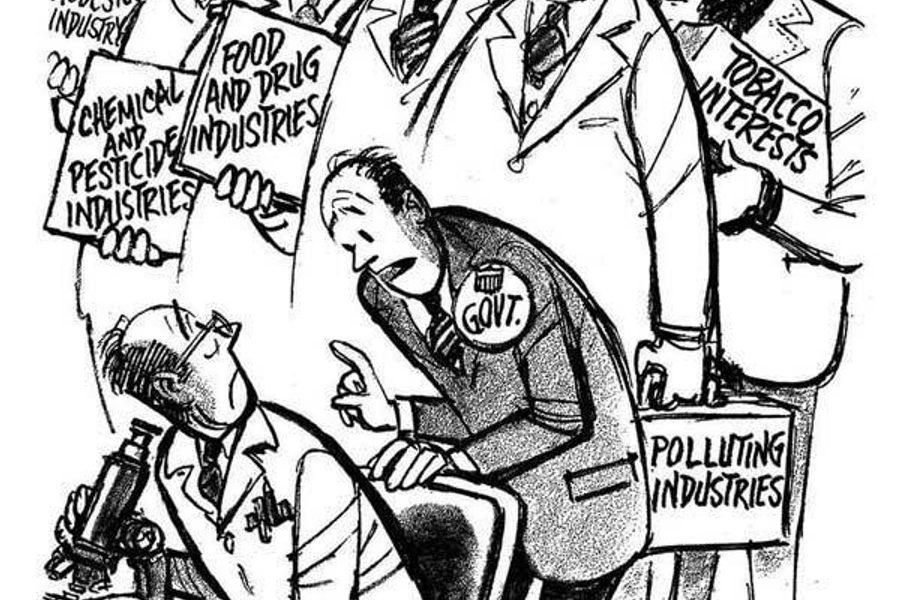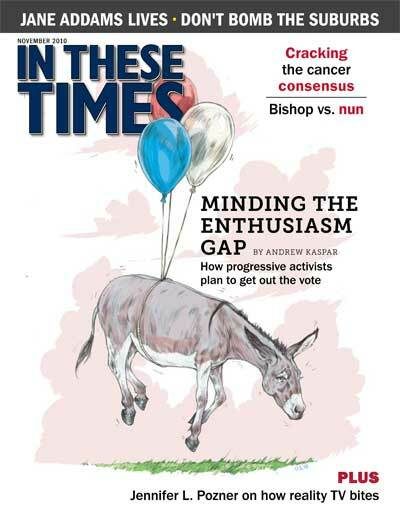
Sitting nervously in the waiting room of her doctor’s office in Peoria, Ill., Margaret is filling in a standard questionnaire. It asks for details of her diet, smoking and drinking habits, family medical history and health conditions. It does not inquire into Margaret’s occupational history, medical imaging screenings, or any routine or acute chemical exposures.
Such information, if collected nationwide, would contribute to a better understanding of how environmental factors impact cancer rates, and thus help better assess a patient’s risk of cancer. Consequently, the 2009 President’s Cancer Panel recommends that primary-care clinics begin collecting such data.
Released in May, the Panel’s 240-page study Reducing Environmental Cancer Risk says that it is better to prevent cancer than to treat it. Previous reports have focused on individual lifestyle choices such as smoking and sun exposure, but have failed to consider exposure to environmental factors, such as agricultural pesticides and industrial chemicals, medical radiation, hazardous waste and conventional weapons testing at military facilities.
According to the Panel, “The true burden of environmentally induced cancers has been grossly underestimated.” It urged President Barack Obama “to use the power of your office to remove the carcinogens and other toxins from our food, water and air that needlessly increase healthcare costs, cripple our nation’s productivity and devastate American lives.”
The Panel, currently comprised of a doctor and an academic, concludes that while understanding of the impact of certain environmental exposures on cancer risk has improved in recent years, inadequate assessment of exposure and ineffective regulation hinder further progress.
“In my experience, this is the single greatest contribution ever to cancer prevention,” says Dr. Samuel Epstein, professor emeritus of environmental and occupational medicine at the University of Illinois School of Public Health. He and other critics say that the narrow focus on “lifestyle factor” prevention strategies implies that when people get cancer, it’s their own fault.
That approach neatly shifts responsibility from the government institutions and corporations that are releasing carcinogens into the human and physical environment to the victims. The National Cancer Institute (NCI), a federal agency, estimates that more than 1.5 million Americans will be diagnosed with some form of cancer in 2010.
It is not just the polluters themselves that promote the lifestyle approach, but also the cancer establishment. The American Cancer Society, the world’s largest nonreligious charity, focuses overwhelmingly on treatment and diagnosis, and has challenged the report’s central findings.
Detractors charge that a cozy relationship with industry skews the Society’s judgment toward the most profitable approaches to fighting cancer.
The breast cancer industry
Take breast cancer. The Society and AstraZeneca are both on the board of sponsors of National Breast Cancer Awareness Month. AstraZeneca is the market leader in breast cancer treatment drugs. It manufactures Tamoxifen, one of the most widely prescribed medications to treat breast cancer and prevent recurrence. In the United States, 500,000 women take the drug and 80,000 new patients begin treatment annually.
In 2009, AstraZeneca reported $88 million in sales of Novaldex (the trade name for Tamoxifen), and its successor, Arimidex, posted sales of $1.9 billion – the company’s highest grossing oncology medication that year. AstraZeneca has contributed at least $10 million to the Society.
Although the Society noted in 1985 that 90 percent of breast cancers were discovered by women themselves, today it recommends annual mammograms beginning at age 40 as the best means of detection.
The problem is mammograms use ionizing radiation, a known carcinogen. While the radiation emitted for a single film is low, multiple films are typically taken for each breast and radiation exposure is cumulative.
In November 2009, the U.S. Preventative Services Task Force (PSTF), a federal panel of health experts, published findings of eight studies conducted over as many years that suggest the potential harm of radiation from mammograms outweighs the benefits for women younger than 50 and older than 74. The PSTF reported that women between the ages of 50 and 74 could safely reduce risk by having screenings every two years, rather than annually.
In light of the PSTF’s findings, the NCI said it would evaluate its screening recommendations; it has not yet modified them. Neither the Society nor the national awareness month websites acknowledge the study, despite the fact that one month prior to its publication, Otis Brawley, the Society’s chief medical officer, admitted to the New York Times that the benefits of mammography were overstated and did not necessarily outweigh the risks.
The Society lists 25 probable and possible risk factors for breast cancer, but radiation is not among them. For its part, the awareness month website documents myriad barriers women face to regular screening, such as lack of time or finances, but fails to discuss serious drawbacks, like the high number of false negatives. (The NCI estimates as many as 40 percent of women who undergo mammograms between the ages of 40 and 49 are told they do not have breast cancer when they actually do.)
Why institutions dedicated to defeating cancer would recommend a single, flawed screening method for breast cancer rather than focus on known causes of the disease, like radiation, is a question of interest to Janette Sherman, a former adviser to the NCI. Sherman, who has written three books on the links between chemicals, radiation and cancer, has a definite idea why prevention is ignored. “There’s no money in it,” she says. “Believe me, there really, really isn’t.”
Medical profits are found in diagnosis and treatment. The 37 million mammograms performed each year, at an average cost of $100, make mammography a multibillion dollar industry. Add in the cost of equipment and biopsies, which can cost between $1,000 and $7,000 each, and breast cancer is a very profitable business.
No one has found a way to get rich by identifying and protecting those at risk of developing cancer. Sherman is involved in a study to better understand if children born in proximity to nuclear power plants have higher levels of a radioactive isotope, strontium 90, by testing their baby teeth for traces of it. “Do you think we can get funding?” she asks. “Absolutely not.”
Prevention activists point to other indications that the Society isn’t committed to a comprehensive fight against cancer. Its board typically includes a preponderance of professionals from the medical communities that focus on treatment and diagnosis. Throughout the ’70s, ’80s and ’90s, the group either failed to support or opposed regulatory action against toxic substances in the environment, including the 1970 Clean Air Act.
Conflicts of cancer interest
Michael Thun, vice president of epidemiology and surveillance research at the Society, denies that his organization’s policy is dictated by corporate interests. “The conspiracy theories that think that big companies are calling the shots at the Cancer Society are just that – conspiracy theories,” he says. At the same time, Thun acknowledges that pharmaceutical companies have a vested interest in treatment, and that conflicts of interest do arise. “There’s always a conflict of interest between the fundraising aspects of an organization and the scientific aspects, and it’s an endless battle.”
Dr. Graham Colditz, an adjunct professor of epidemiology at Washington University School of Medicine, agrees with the Panel’s decision to warn of the risks of radiation exposure. However, he says that such warnings distract from those lifestyle prevention strategies proven to reduce the incidence of cancer – abstention from smoking, for example. “I’m not saying we shouldn’t be testing [chemicals], but to do that and not pay attention to the known causes of cancer is doing a social disservice,” Colditz says.
Over the years, researchers have discovered that humans have been routinely exposed to man-made chemicals that cause cancer. The synthetic estrogen, diethylstilbestrol (DES), first prescribed in 1938 to reduce the risk of complications during pregnancy, has been shown to cause a rare vaginal cancer in female offspring, as well as an increased risk of breast cancer in mothers. Before the FDA advised against its use in 1971, 5 to 10 million people were exposed to the hormone. Likewise asbestos, the once ubiquitous flame-retardant construction material, has been linked to several types of cancer. A 1989 ruling by the Environmental Protection Agency partially banned its use.
The Panel calls for a new regulatory approach: Rather than screening for toxicity only after people have gotten sick, it is advocating a precautionary system that tracks individual patients’ cumulative exposure to radiation and requires chemical manufacturers to prove their chemicals are safe before marketing them.
Federal regulators have historically been loathe to saddle manufacturers with prolonged, expensive studies. And Thun says it is difficult to determine “safe” levels of exposure. “We have very clear evidence of human effects at high doses, but everything at low doses is based on linear extrapolation” that extends conclusions beyond what has actually been demonstrated, he says. “The studies are never large enough to measure the magnitude of the effect.” The Society maintains that the science does not support the panel report’s central thesis that the number of environmentally induced cancers has been “grossly underestimated.”
Richard Clapp of the Boston University School of Public Health, who testified before the 2009 panel, stands by the descriptor. “We don’t need to know the fine details of how these exposures cause cancers – we know enough to act,” he says. He cites a graph featured in a 2008 report on the increased rate of childhood cancer.
Provided by the NCI’s Surveillance Epidemiology and End Result Department, the graph shows that between 1975 and 2006 the incidence of cancer for children under 20 of all races and both sexes rose steadily; this cannot be accounted for by better diagnoses. Thanks to improved treatments, mortality fell during this period, yet the ascending incidence remains unexplained. The trend is “very worrisome,” Thun says. “It’s a very important thing to follow up.”
Clapp is more blunt: “That’s not some bad lifestyles or having a stressful job. That’s because something in the environment is causing a steady rise in cancer in kids.”
Clapp says this year’s report is “redirecting an imbalance” by putting a greater emphasis on environmental factors. The two previous panel reports focused exclusively on known causes of cancer. In 2008, ridding the nation of tobacco was among the panel’s three chief recommendations. In 2007 it reported on avoidable lifestyle factors known to cause cancer, detailing the importance of diet, nutrition, physical activity and eliminating tobacco use.
The Society contributes to the lifestyle side of the imbalance by failing to prioritize improved knowledge of cancer causation. It has no department dedicated to researching pollutants, and continues to maintain that resources for prevention should be spent where it says there is the most potential benefit: tobacco, diet and exercise.
Since the Panel’s report was released in May, however, the Society has broadened its prevention efforts, recommending that 20 “high-priority” possible carcinogens typically present in occupational environments be further studied.
The ACS is committed to treatment and diagnosis, as are the industry giants making billions of dollars meeting the demands of its recommendations. Funneling more public money to the problem has not made significant inroads either; although funding for the NCI increased from $337,000 in 1971 to nearly $5 billion in 2008, Americans have a greater chance today of contracting some form of the disease than they did in the early 1970s.
Healthcare is a business, but not like any other. A September 9 article in the New England Journal of Medicine puts it this way: “It is only in health care, after all, that the same group that provides a service also tells us how valuable that service is and how much we need, as when the Society of Breast Imaging sets the recommendations for mammography.”
Current research priorities favor the multibillion-dollar industry that profits from diagnosis and treatment. To begin decreasing the overall incidence of cancer, the system of funding must evolve. Yet if the fight against cancer is to be won, research will have to concentrate on areas most likely to produce results, both for those who have cancer and for those who don’t – yet.

I hope you found this article important. Before you leave, I want to ask you to consider supporting our work with a donation. In These Times needs readers like you to help sustain our mission. We don’t depend on—or want—corporate advertising or deep-pocketed billionaires to fund our journalism. We’re supported by you, the reader, so we can focus on covering the issues that matter most to the progressive movement without fear or compromise.
Our work isn’t hidden behind a paywall because of people like you who support our journalism. We want to keep it that way. If you value the work we do and the movements we cover, please consider donating to In These Times.




